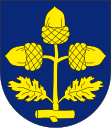Bukovinka
| Bukovinka | ||||
|---|---|---|---|---|
|
||||
| Basic data | ||||
| State : |
|
|||
| Region : | Jihomoravský kraj | |||
| District : | Blansko | |||
| Area : | 848 ha | |||
| Geographic location : | 49 ° 18 ' N , 16 ° 48' E | |||
| Height: | 520 m nm | |||
| Residents : | 582 (Jan. 1, 2019) | |||
| Postal code : | 679 05 | |||
| License plate : | B. | |||
| traffic | ||||
| Street: | Vyškov - Křtiny | |||
| Next international airport : | Brno-Tuřany | |||
| structure | ||||
| Status: | local community | |||
| Districts: | 1 | |||
| administration | ||||
| Mayor : | Pavel Malík (as of 2018) | |||
| Address: | Bukovinka 126 679 05 Křtiny |
|||
| Municipality number: | 581453 | |||
| Website : | www.bukovinka.cz | |||
Bukovinka (German Klein Bukowin , also Klein Bukowina ) is a municipality in the Czech Republic . It is located 18 kilometers northeast of the city center of Brno and belongs to the Okres Blansko .
geography
Bukovinka is located on a hill in the Drahaner Bergland . The village is surrounded by large forest areas. In the western part of the village the stream Strhovec rises, northwest of the Křtinský potok, north of the Malý Rakovec and southeast of the Říčka. Bukovinka is located on the northern edge of the Říčky Nature Park, to the northeast is the Rakovecké údolí Nature Park.
Neighboring towns are Rakovec, Kotvrdovice , Senetářov and Podomí the north, Ruprechtov in the Northeast, Pastviny and Ježkovice the east, Říčky, Račice and Olšany in the southeast, Vítovice , Viničné Šumice , Jezera and Hostěnice in the south, Lhotky, Proseč and Březina in the southwest, Bukovina in the west and Rudice , Stará Huť, Chaloupky and Jedovnice in the north-west.
North are the abandoned settlements Bystřec and Vilémov, east of the deserted village Sokolí, southwest the deserted village Lhota and northwest, the deserted village Budkovany.
history
Legends tell that in 1210 at the location of the old church an apparition of Mary is said to have taken place. Subsequently, hermits lived here and took care of the statue of the Virgin Mary. The place was first mentioned in writing in 1268, when Hartmann von Hohlenstein donated the village of Bukovina, which belonged to the Jedovnice rulership , to the Premonstratensian monastery Obrowitz after his death . The church was probably built a little later. In 1283 the donation through the village of Bukovina with the church and forests as well as the Bukovina farm was confirmed and carried out. The church was damaged during the Hussite Wars and later restored by the last hermit, Pavel. After he died in 1475, the statue of Mary with the baby Jesus was brought to Křtiny . In 1558, 1571, 1577 and 1584 the area was hit by plague epidemics. During the Thirty Years War, Bukovinka was sacked by Swedish troops in 1645. Through the betrayal of the farmer Vokoun from Olomučany , the Swedes captured the Nový hrad castle and burned it down. The oldest local seal dates from 1668 and bears the inscription Wubec Male Bukovinky . In 1673 the consequences of the Thirty Years War were still noticeable, six of the 21 properties in the village were in desolation. In 1750 Malaá Bukovina consisted of 19 farms. In 1772 the church burned down. After the abolition of the monastery in the course of the Josephine reforms , Malá Bukovina became part of the secular rule Obrowitz in 1784 and was subject to the Kiritein estate. In 1790, 161 people lived in the 30 houses of the village. The first village school was built in 1804. In 1830 the Imperial and Royal State Goods Disposal Commission sold the Obrowitz estate with all its accessories for the highest bid for 222,000 florins to Franz Xaver von Dietrichstein- Proskau. In 1834 the village had 298 inhabitants.
After the abolition of patrimonial formed Malá Bukovina / Klein Bukovina in 1850 a political community in the district administration Brno . In 1869 the village had 373 inhabitants. The place name Bukovinka has been used since the end of the 19th century . In 1890 Bukovinka had grown to 66 houses. The village had 449 inhabitants, all of them Catholic, who, with the exception of three Germans, belonged to the Czech ethnic group. In 1921 Bukovinka was assigned to the Okres Brno-venkov . Since 1948 the community has belonged to Okres Blansko . In 2001 there were 309 people in Bukovinka. The parish is Křtiny .
Community structure
No districts are shown for the municipality of Bukovinka. The one-layer Rakovec belongs to Bukovinka .
Attractions
- Baroque branch church Maria Himmelfahrt, it was built in 1773 south of the previous church
- Ruins of the cemetery chapel, the chapel is a remnant of the 13th century church that burned down in 1772. The old cemetery was around the chapel.
- Lady Chapel from the 19th century
- Memorial to the victims of both world wars
- Rakovec nature reserve, north of the village
- Three spruce trees on the Vilémov desert


